Blubrry Podcasting AI Production System: Episode Production Guide
Introduction
The Blubrry Podcasting AI Production System facilitates podcasters in crafting and managing their podcast episodes efficiently. This guide provides instructions on starting an episode production, choosing from existing plans, or creating an entirely new production plan.
Starting an Episode Production
Selecting a Plan
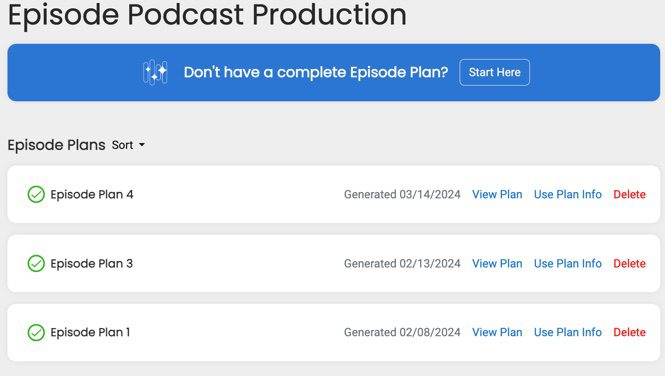
When you’re ready to begin producing an episode, you have two options:
- Choose from an Existing Plan: You can select a previously created plan. Each plan includes a unique title, creation date, and an option to either ‘View Production’ or ‘Delete’ the plan.
- Create a New Production: If no plans fit your current needs, you can start a new production by clicking the ‘New Production’ button.
Episode Productions Interface
The Episode Productions page displays all your production plans, outlined as follows:
- Episode Title: This is the name of your production plan, giving you a clear idea of the content for that episode.
- Date Generated: Indicates when the plan was created or last updated.
- Actions: Each plan has actionable buttons allowing you to either view the complete production details or delete the plan if it’s no longer needed.
Steps for Creating a New Production Plan
If you decide to create a new production plan, follow these general steps:
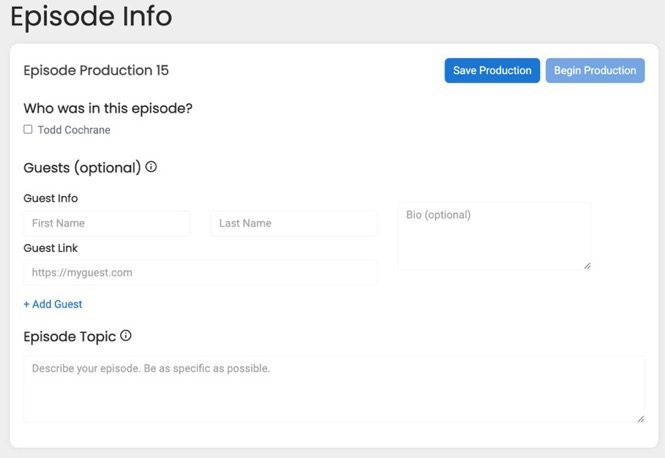
New Production Plan Overview
A New Production Plan is the blueprint for your podcast episode. It includes information about the hosts, guests, and the central topic you will cover. This form is the foundation for your episode, whether it’s the preliminary step for first-time podcasters or a subsequent episode for seasoned creators.
Steps to Create a New Production Plan
1. Host Details
Select the hosts who will be present in the episode. Check the corresponding boxes for the individuals involved, it will by default show you the hosts who are in your show profile.
2. Guest Information (Optional)
If you have guests featured in your episode:
- Guest Info: Provide the first and last names of your guest(s).
- Guest Link: Enter a URL to your guest’s professional profile, personal website, or related content.
- Bio (Optional): Include a short biography for each guest, offering listeners context about who is speaking and why they’re an authority on the episode’s topic.
Click Add Guest to include additional guests, repeating the steps above for each one.
3. Episode Topic
In the provided field, describe the specific focus of your episode. The more detailed you are, the better-tailored the content generation will be.
Managing Your Productions
Viewing a Production
By selecting ‘View Production’ next to any listed plan, you can access the full details of your episode’s content, including topics, goals, guest information, and the generated show flow.
Editing a Production
Within the ‘View Production’ interface, you can edit various elements of your episode, ensuring that the final output aligns with your vision.
Deleting a Production
If a particular plan is no longer relevant, you can remove it from your list by selecting the ‘Delete’ button. This helps keep your production page clean and organized.
Conclusion
The Blubrry Podcasting AI Production System’s Episode Production page is a central hub where podcasters can oversee their podcast episodes from conception to realization. Whether you’re drawing from an existing plan or starting fresh, the system offers the tools to create a professional and engaging podcast episode.
For additional assistance or to address any questions, the Blubrry Podcasting support team is available to help you navigate the production process and maximize the potential of your podcast episodes.
Note to Podcasters: The flexibility of the Blubrry AI Production System ensures that whether you’re an experienced podcaster or just starting, you can tailor the production process to fit your needs. Use this system to its full potential to streamline your podcast production and consistently create high-quality content.
Blubrry Podcasting AI Production System: Step 1: Transcript Generation
Introduction
After initiating a production within the Blubrry Podcasting AI Production System, one of the first steps is to manage the episode’s media file. This involves uploading or selecting the file and associating transcript segments with the host(s) and guest(s). The system offers different transcript formats for external use, including VTT, PDF, and SRT files.
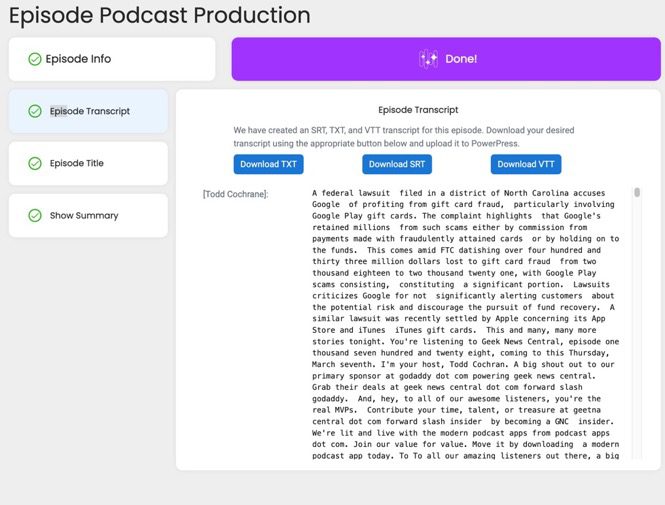
Upload or Select Media File
- Start Production: Initiate the process by uploading or selecting the media file for your episode.
- File Processing: The AI will process the audio to create a transcript.
Transcript Matching
- Review Transcript: Once the transcript is generated, review the document and match the text to the correct speaker, whether a host or a guest.
- Segment Association: Assign transcript segments to the corresponding individuals to ensure accurate representation and clarity for listeners.
Transcript Formats
- VTT (Web Video Text Tracks): This format is used for captioning video content and is compatible with most web video players.
- SRT (SubRip Subtitle): A standard format for movie and video subtitles, applicable to various media players.
- TXT (Text File): A plain text version of your transcript, usable in various applications.
Conclusion
The transcript generation and management feature of the Blubrry Podcasting AI Production System is a powerful tool for podcasters, offering efficiency in production and flexibility in content distribution. Following these guidelines ensures that your transcripts are accurate and available in formats that best serve your audience’s needs.
Remember to use the different transcript formats to cater to diverse platforms and increase your podcast’s accessibility.
Blubrry Podcasting AI Production System: Episode Title Selection Guide
Introduction
Choosing the right title for your podcast episode is crucial for attracting listeners and giving them an overview of the content. Blubrry Podcasting AI Production System aids this process by analyzing the episode transcript and suggesting a list of potential titles. Podcasters can select from these AI-generated titles or create their own. This guide details how to navigate the title selection feature.
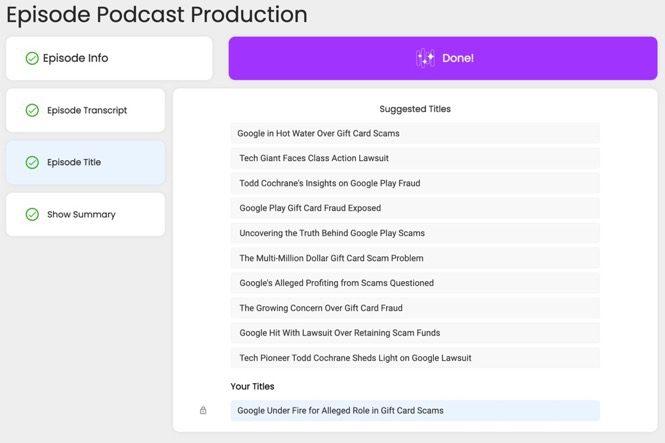
Episode Title Suggestions
AI-Generated Titles
The AI system proposes a set of titles derived from the content within the episode’s transcript. These suggestions are designed to be catchy, relevant, and reflective of the episode’s main points.
How to Select a Title
- Review Suggested Titles: Look through the list of AI-generated titles. They typically include critical phrases from the episode, ensuring relevance to the content.
- Choose a Title: Select a title that best encapsulates the episode’s essence. The correct title can intrigue potential listeners, communicate the episode’s focus, and show higher in relevant search results.
Adding Your Title
- Your Titles Section: If none of the suggested titles resonate with you or have a specific title in mind, enter it in the “Your Titles” field.
- Customization: This allows for complete control over how the episode is presented to your audience, ensuring the title aligns with your podcast’s branding and the episode’s message.
Best Practices for Title Selection
- Reflect Content: Choose a title that accurately reflects the content of your podcast episode.
- Keep it Concise: A title should be brief yet descriptive enough to give listeners a clear idea of what to expect.
- Incorporate Keywords: Use relevant keywords that potential listeners may use when searching for content on your topic.
- Engage Emotion or Curiosity: A good title can evoke curiosity or an emotional response, prompting listeners to engage with your episode.
Conclusion
The title of your podcast episode plays a significant role in the success of your content. Utilizing AI-generated titles can save time and inspire, but adding your personal touch ensures the title fits your unique style and content strategy.
Once you have selected or entered your title, click ‘Done!’ to finalize your choice. Your episode title is now ready to be shared with the world.
Blubrry Podcasting AI Production System: Show Summary and Bullet Points Guide
Introduction
Crafting a captivating show summary and precise bullet points is a critical step in post-production. The Blubrry Podcasting AI Production System assists podcasters by generating a complete summary and key bullet points encompassing the episode’s full scope. While AI provides a strong starting point, podcasters must review and personalize this content to ensure accuracy and alignment with the episode’s essence. This guide will provide instructions on how to refine these AI-generated components effectively.
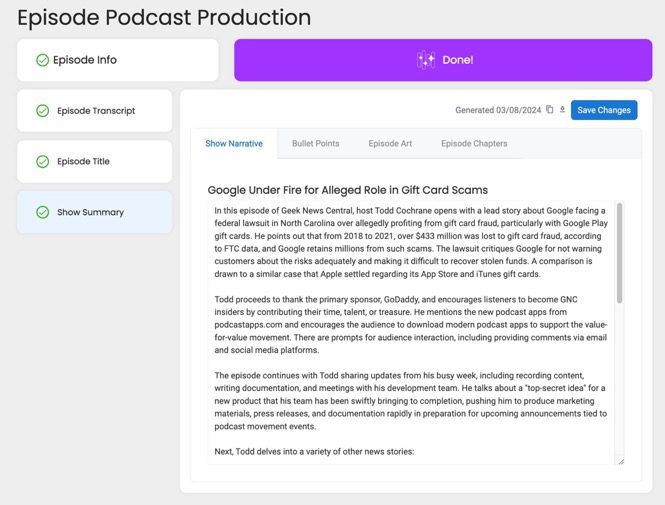
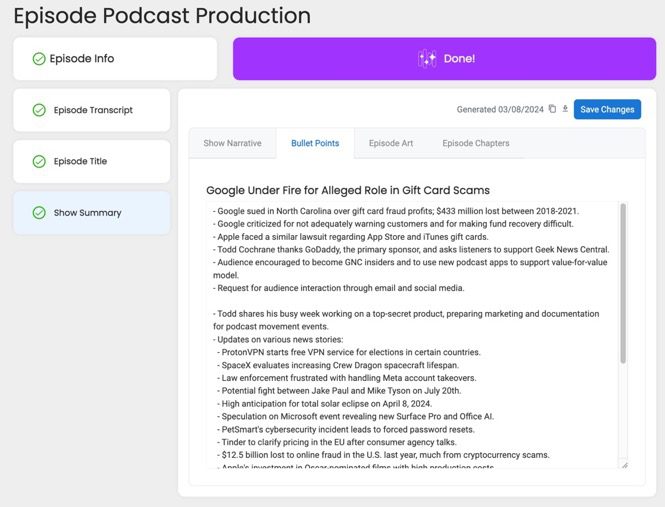
Show Summary and Bullet Points Overview
AI-Generated Summary
The system creates a detailed summary that reflects the entire show’s content, offering listeners a snapshot of what to expect. This narrative is designed to encapsulate the main topics, guest contributions, and any particular notable segments or announcements.
AI-Generated Bullet Points
Alongside the summary, bullet points are provided to break down the episode’s content into easily digestible highlights. These points serve as a quick reference for the podcaster during the review and the audience when they access the episode.
Reviewing and Editing
Importance of Review
- Accuracy: Ensure that the AI-generated summary and bullet points accurately represent the episode’s content and the discussions.
- Relevance: Adjust the summary and bullet points to highlight the most relevant and engaging parts of the episode.
- Tone and Style: Edit the language to match the tone and style of your podcast, making it relatable and recognizable to your audience.
Editing Tips
- Personal Touch: Add anecdotes or notable quotes from the episode to give a personal touch to the summary.
- Clarity: Ensure the summary and bullet points are clear and concise, avoiding any confusion for the listener.
- Calls to Action: Include any calls to action or important links in the episode to guide listeners on where to find more information or how to engage further.
Finalizing the Show Summary
Once the summary and bullet points have been reviewed and edited:
- Save Changes: Click this button to save the refined summary and bullet points.
- Final Review: It is recommended to do a final read-through to catch any remaining issues or to make last-minute tweaks.
Conclusion
A well-crafted show summary and thoughtfully selected bullet points are essential elements that contribute to the accessibility and appeal of your podcast episode. The AI-generated summary and bullet points should serve as a draft for podcasters to build upon. Personal review and editing are crucial to ensure that the final content accurately conveys your podcast’s value and unique perspective to your audience.
Remember, the summary and bullet points are often the first pieces of content your audience will encounter, so making them impactful and reflective of the episode is key to drawing listeners in.
Blubrry Podcasting AI Production System: Episode Art Generation Guide
Introduction
Visual elements such as episode art are crucial in distinguishing your podcast and attracting listeners. The Blubrry Podcasting AI Production System provides a feature for generating appealing episode art that aligns with your content. This guide will walk you through creating and selecting episode art for your podcast.
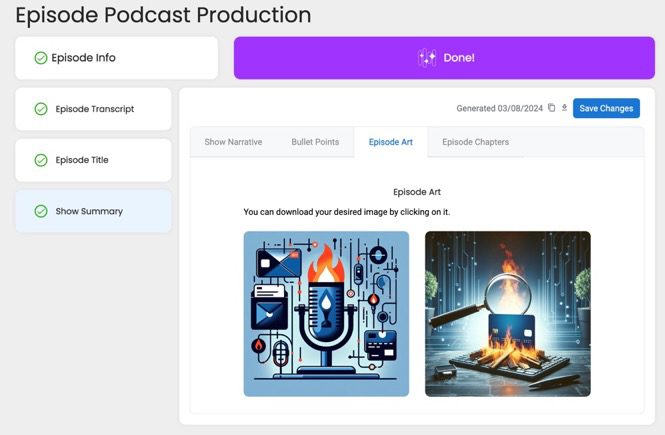
Episode Art Generation
Pre-Generation Prompt Customization
Before generating episode art, podcasters can update or modify the AI’s default prompt. It’s encouraged to tailor the prompt to reflect the episode’s theme more accurately, ensuring the artwork is relevant and engaging.
AI-Generated Art
Once the prompt is finalized:
- Art Creation: The AI will generate two images based on the prompt. These images are created to meet the technical specifications required by popular podcast platforms, including Apple Podcasts.
- Image Selection: The podcaster is presented with both images and can select their preferred art to accompany the episode. The images will adhere to the minimum size specifications of 1400×1400 pixels.
- One-Time Generation: It’s important to note that podcasters have only one opportunity to generate episode art, emphasizing the need to consider the prompt carefully before submission.
Downloading Episode Art
- Choose Your Art: Click on the image you wish to use for your episode. This will visually represent your episode across various platforms and directories.
- Download: After selecting the desired artwork, download the file to your local system.
- Use in Publication: The downloaded art can be attached to your episode metadata when publishing on podcast platforms.
Tips for Effective Episode Art Creation
- Reflect the Episode’s Content: Ensure the prompt includes key themes or subjects from the episode so the art represents the content.
- Be Descriptive: The more descriptive the prompt, the better the AI can visualize and create artwork that stands out.
- Consider Brand Consistency: While each episode can have unique art, it should still align with the overall branding of your podcast.
Conclusion
Episode art is a powerful tool in a podcaster’s arsenal for attracting and retaining listeners. By leveraging the Blubrry Podcasting AI Production System, podcasters can create professional and compelling images that resonate with their audience and enhance the visual appeal of their podcast.
Remember to review the generated artwork thoroughly and choose the one that best complements your episode, ensuring that it catches the eye of potential listeners and accurately conveys the episode’s topic.
Blubrry Podcasting AI Production System: Chapter File Generation Guide
Introduction
The final stage in the AI production process is the generation of episode chapters. Chapters enhance the listening experience by providing time-stamped segments throughout the episode, allowing listeners to navigate to specific parts of the content. The Blubrry Podcasting AI Production System automates this by creating time hacks and titles for each AI-generated chapter. Podcasters can enrich these chapters with HTML links and images. The completed chapter file is then integrated into the production flow for a seamless drafting process.
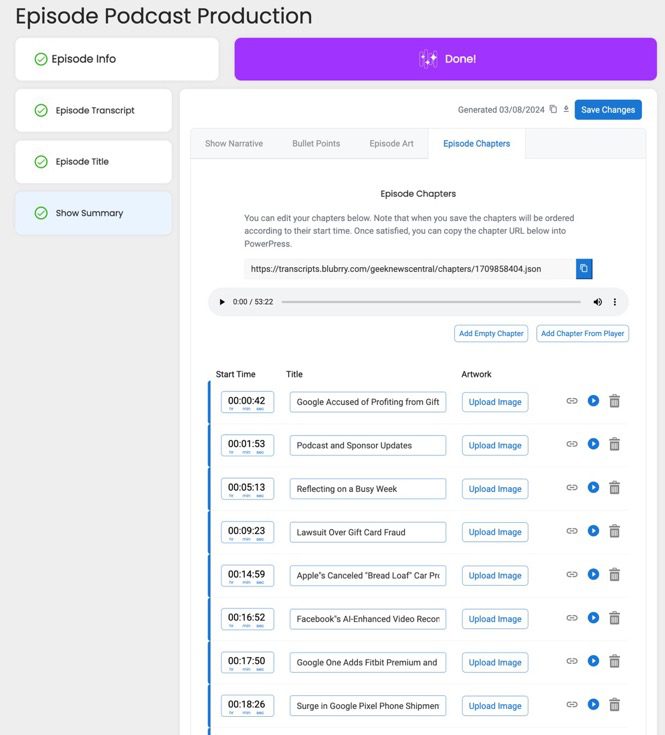
Chapter File Generation and Customization
AI-Generated Chapters
The AI system automatically generates chapters based on the content and structure of your episode, marking significant segments with time hacks.
Editing Chapters
- Chapter Titles: Review and edit the titles for each chapter to accurately reflect the content within that segment.
- Start Time: Adjust the start times if necessary to ensure that chapters begin at the correct points in the audio.
- Artwork: Upload images corresponding to each chapter’s topic, adding a visual element to the auditory content.
Adding HTML Links
- Interactive Experience: Incorporate HTML links within the chapter details to provide listeners with resources, further reading, or promotional content.
- Supporting Content: Use links to connect your audience with any mentioned products, services, or websites.
Chapter File URL
Once chapters are finalized:
- Chapter File URL: Copy this link into the podcast production flow. It is directed to a JSON file that contains all the chapter information that can be used in podcast players to support chapter files. For dashboard users, this link is included in the draft episode. PowerPress users can copy the link and add it to the episode.
Integration with Blubrry Publisher
For Blubrry publisher users:
- Draft Episode: Find a pre-populated draft episode in the publisher area that includes the show title, edited show summary, episode art, transcript, and chapter files, along with the media file.
- Full Editability: Before publishing, you can fully edit the draft to ensure that every aspect of the episode is perfect.
Maximizing Podcast Workflow
The AI production system is designed to optimize post-production workflow by:
- Streamlining Processes: Minimize manual work and provide a structured approach to episode creation.
- Enhancing Content Delivery: Offering features that enrich the podcast, such as chapters, for better listener engagement.
- Ensuring Quality Control: Giving podcasters the tools to oversee and fine-tune content before it goes live.
Conclusion
The Blubrry Podcasting AI Production System provides an end-to-end solution that assists podcasters in creating a polished and professional podcast episode. The chapter file generation is integral to this system, contributing to an organized and listener-friendly podcast. By following this guide, podcasters can ensure their episodes are engaging and easy to navigate.
Remember, while the AI provides a strong foundation, the podcaster’s review and customization truly bring an episode to life.




